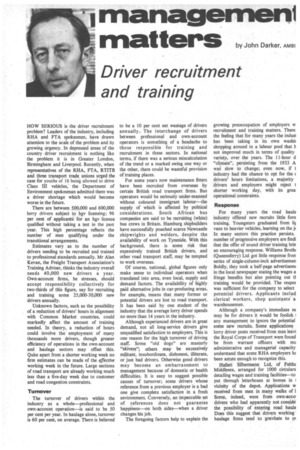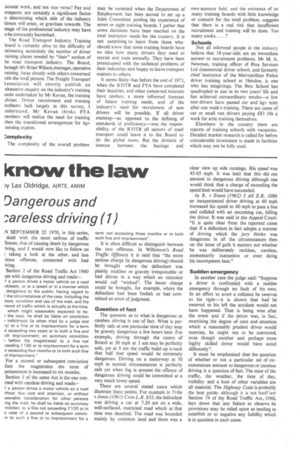managemeni
Page 116

Page 117

If you've noticed an error in this article please click here to report it so we can fix it.
matters by John Darker AMBI
Driver recruitment and training
HOW SERIOUS is the driver recruitment problem? Leaders of the industry, including RHA and FTA spokesmen, have drawn attention to the scale of the problem and its growing urgency. In depressed areas of the country driver recruitment is nothing like the problem it is in Greater London, Birmingham and Liverpool. Recently, when representatives of the RHA, PTA, RTITB and three transport trade unions urged the ease for youths of 18 being allowed to drive Class III vehicles, the Department of Environment spokesman admitted there was a driver shortage which would become worse in the future.
There are between 500,000 and 600,000 lorry drivers subject to hgv licensing: 96 per cent of applicants for an hgv licence qualified without taking a test in the past year. This high percentage reflects the number of men qualifying under the transitional arrangements.
Estimates vary as to the number of drivers needing to be recruited and trained to professional standards annually. Mr Alan Kevan, the Freight Transport Association's Training Adviser, thinks the industry overall needs 40,000 new drivers a year. Own-account firms, he stresses, should accept responsibility collectively for two-thirds of this figure, say for recruiting and training some 25,000-30,000 new drivers annually.
Unknown factors, such as the possibility of a reduction of drivers' hours in alignment with Common Market countries, could markedly affect the amount of training needed. In theory, a reduction of hours could involve the employment of many thousands more drivers, though greater efficiency of operations in the own-account and haulage sectors may offset this. Quite apart from a shorter working week no firm estimates can be made of the effective working week in the future, Large sections of road transport are already working much less than a five-day week due to customer and road congestion constraints.
Turnover
The turnover of drivers within the industry as a whole—professional and own-account operation—is said to be 50 per cent per year. In haulage alone, turnover is 60 per cent, on average. There is believed to be a 10 per cent net wastage of drivers annually. The interchange of drivers between professional and own-account operators is something of a headache to those responsible for training and recruitment in these sectors. In national terms, if there was a serious miscalculation of the trend or a marked swing one way or the other, there could be wasteful provision of training places.
For some years now maintenance fitters have been recruited from overseas by certain British road transport firms. Bus operators would be seriously under-manned without coloured immigrant labour—the supply of which is affected by political considerations. South African bus companies are said to be recruiting (white) bus crews in Britain. Hamburg shipbuilders have successfully poached scarce Newcastle shipwrights and welders, despite the availability of work on Tyneside. With this background, there is some risk that expensively trained British drivers, and other road transport staff, may be tempted to work overseas.
Of course, national, global figures only make sense to individual operators when translated into area, even local, supply and demand factors. The availability of highly paid alternative jobs in car-producing areas, for example, means that many former or potential drivers are lost to road transport. It has been said by one student of the industry that the average lorry driver spends no more than 14 years in the industry.
Although experienced drivers are in great demand, not all long-service drivers give unqualified satisfaction to employers. This is one reason for the high turnover of driving staff. Some "old dogs" arc masterly "skivers"; others may be excessively militant, insubordinate, dishonest, illiterate, or just bad drivers. Otherwise good drivers may become an embarrassment to management because of domestic or health difficulties. It is easy to suggest possible causes of turnover; some drivers whose reference from a previous employer is a bad one give complete satisfaction in a fresh environment. Conversely, an impeccable set of references does not guarantee happiness—on both sides—when a driver changes his job.
The foregoing factors help to explain the growing preoccupation of employers w recruitment and training matters. There the feeling that for many years the indusi has been taking in its own washit shopping around in a labour pool that not improved much in terms of quality variety, over the years. The 11-hour d "climate", persisting from the 1933 A wa slow to change; even now, if 1 industry had the chance to opt for the ( drivers' hours limitations, a majority drivers and employers might reject shorter working day, with its grea operational constraints.
Response
For many years the road haula industry offered new recruits little forn training. Youngsters graduated from vans to heavier vehicles, learning on the jc In many sectors this practice persists. number of progressive employers are findi that the offer of sound driver training brir an encouraging response. Williams Brothl (Queensferry) Ltd got little response fron series of single-column-inch advertisemer Boldly, they took a half-page advertiserm in the local newspaper stating the wages a fringe benefits but also pointing out ti training would be provided. The respot was sufficient for the company to select potential drivers. Applicants includ clerical workers, shop assistants a warehousemen.
Although a company's immediate ne may be for drivers it would be foolish I any management to ignore the potential some new recruits. Some applications lorry driver posts received from men leavi the Royal Corps of Transport were found be from warrant officers with mu administrative and managerial capacity understand that some RHA employers hi been astute enough to recognize this.
Hallett Silbermann Ltd, of Felth Middlesex, arranged for 1000 circulars detailing wages and training facilities—to put through letterboxes at homes in 1 vicinity of the depot. Applications w received from men in many walks of 1 Some, indeed, were from own-acco drivers who had apparently not conside the possibility of entering road haula Does this suggest that drivers working haulage firms tend to gravitate to cr Lccount work, and not vice versa? Pay and vospects are certainly a significant factor n determining which side of the industry 'rivers will enter, or gravitate towards. The mage of the professional industry may have o be constantly burnished.
The Road Transport Industry Training 3oard is certainly alive to the difficulty of :stimating accurately the number of driver raining places needed by "their" section of he road transport industry. The Board, hrough Mr Brian Wilson, manager, operative raining, liaise closely with others concerned vith the total picture. The Freight Transport kssociation will shortly publish an :xhaustive enquiry on the industry's training Leeds undertaken by Mr Kevan, the training Idviser. Driver recruitment and training problems bulk largely in this survey, I inderstand. Mr Kevan thinks FTA nembers will realize the need for training then the transitional arrangement for hgv censing expires.
:omplexity The complexity of the overall problem
may be surmised when the Department of Employment has been moved to set up a Joint Committee pooling the experience of seven or eight training boards. I gather that some decisions have been reached on the total instructor needs for the country. It is not surprising to learn from those who should know that some training boards have no idea how many drivers they need to recruit and train annually. They have been preoccupied with the technical problems of their industries and happy to leave transport matters to others.
It seems likely that before the end of 1971, when the RTITB and FTA have completed their inquiries, and other concerned interests have spoken, a more informed forecast of future training needs, and of the industry's need for recruitment of new drivers will be possible. If all driver training—as opposed to the defining of standards of proficiency—was the responsibility of the RTITB all sectors of road transport could leave it to the Board to do the global sums. But the division of interest between the haulage and
own-account field, and the existence of so many training boards with little knowledge or concern for the total problem, suggests that there is a real risk that insufficient recruitment and training will be done. Too many cooks.... ?
Schools Not all informed people in the industry believe that I 8-year-olds are an immediate answer to recruitment problems. Mr M. A. Newman, training officer of Blox Services Ltd dommercial driver school, and formerly chief instructor of the Metropolitan Police driver training school at Hendon, is one who has misgivings. The Blox School has quadrupled in size in its two years' life and has achieved extraordinary results—a few non-drivers have passed car and hgv tests after one week's training. There are cases of car or small van drivers paying £83 lOs a week for artic training themselves.
Elsewhere in the country there are reports of training schools with vacancies. Detailed market research is called for before considerable investment is made in facilities which may not be fully used.






































































































































































